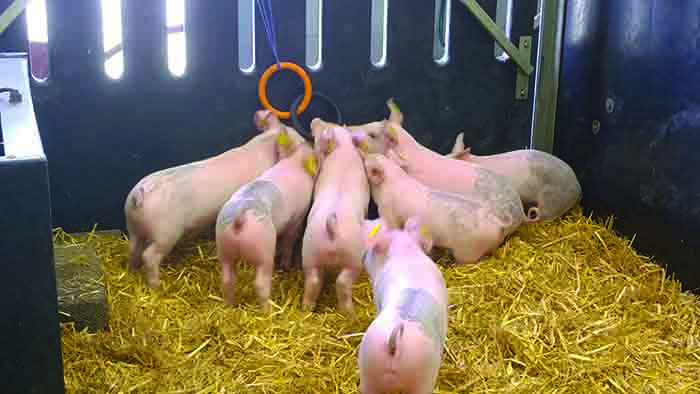The key points to consider when it comes to providing environmental enrichment for pigs
Providing suitable environmental enrichment can make a huge contribution to improving pigs’ living conditions. The practice is therefore an essential part of the drive to tackle tail biting. Getting it right is not easy, but there is excellent guidance available in AHDB’s guide Environmental enrichment for pigs.
WHY IS IT IMPORTANT?
Pigs are naturally curious and in semi- natural surroundings spend 75% of their time burrowing, foraging and exploring. Providing objects or materials for proper investigation and manipulation helps reduce the frequency of abnormal behaviour, such as tail biting and aggression.
It broadens the range of behaviours expressed, while pigs raised in enriched housing react less aggressively to changes in their surroundings and are therefore easier to handle.
Enrichment also improves performance, including feed intake, average daily gain (ADG) and feed conversion ratio (FCR).
WHAT ARE THE LEGAL REQUIREMENTS?
UK law makes it a legal requirement for pig farmers to provide enrichment at all production stages, including sows. It stipulates that pigs must have permanent access to environmental enrichment materials in ‘a sufficient quantity of material to enable proper investigation and manipulation activities… which does not compromise the health of the animals’.
EU law also recognises the importance of foraging and investigative behaviour for pig welfare. In 2016, the European Commission set out guidance to reduce the need for tail docking, which included outlining the key characteristics environmental enrichment materials should have.
WHAT ARE THE KEY CHARACTERISTICS OF ENRICHMENT MATERIALS?
The objects and materials should fulfil the following attributes:
Safe – for pigs and stockpersons.
Edible or feed-like – so pigs can eat or smell them, preferably with some nutritional benefits.
Chewable – so pigs can bite them.
Investigable – so pigs can investigate them, allowing them to root with their snout.
Manipulable or deformable – so pigs can change the material’s location, appearance or structure. Novelty is key to maintaining a pig’s interest in an object. Therefore, enrichment materials should also be provided in such a way that they are:
Of sustainable interest – enrichments should encourage the exploratory behaviour of pigs and be regularly replaced, replenished or rotated.
Accessible – for oral manipulation to all pigs at all times, and presented at a height that pigs can easily interact with them, yet be kept clean.
Given in sufficient quantity – for any pig to gain access when they are motivated to do so, and so as not to generate competition between pigs.
Clean and hygienic – pigs will rapidly lose interest in soiled enrichment materials.
WHAT ITEMS SHOULD BE USED?
Enrichment materials should meet all the above characteristics to comply with the legal requirements. If not, a combination of materials is essential.
Good-quality straw as bedding satisfies all criteria for good enrichment materials and can be used alone. However, straw is not always practical as a bedding material. Other materials used as bedding, such
as wood shavings, shredded paper, soil and sand, usually meet the needs for investigation and manipulation but are not necessarily edible or chewable.
A combination of materials – such as natural ropes, root vegetables, forage in racks, compressed straw in cylinders, hessian cloth bags, rubber or plastic items, commercially available toys, chains or wood – should be used in systems where bedding cannot be provided as a source of enrichment.
WHAT ITEMS SHOULD NOT BE USED?
Non-virgin wood could contain sharp objects, and synthetic rope and tyres may contain wire or metal strips.
Also to be avoided are materials with the risk of biological or chemical contaminants, such as peat/mushroom compost, dog chews made from animal products, and dirty or soiled objects.
More detailed information can be found in AHDB’s enrichment guide, which is available by clicking HERE.
WHAT DOES RED TRACTOR REQUIRE?
The Red Tractor scheme stipulates that pigs must have permanent access to environmental enrichment. Its standards cite straw, hay, wood and sawdust as acceptable enrichment. Objects such as footballs and deformable-plastic pipe will only be regarded as satisfactory when demonstrated to satisfy investigation and manipulation activities. Chains alone are not acceptable and manipulable material containing wire, such as tyres, should not be used.




